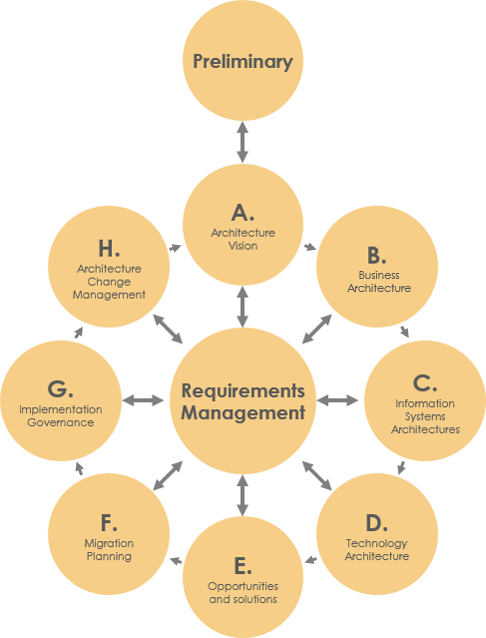Introduction
In the dynamic realm of enterprise architecture, the TOGAF 10 standard emerges as a beacon of innovation and adaptability. With its roots tracing back to 1995, TOGAF has evolved into the world’s most widely-used architecture framework, and its 10th edition, introduced on April 25, 2022, marks a significant milestone. This open standard framework revolutionizes the approach to designing, planning, implementing, and governing an enterprise’s information technology infrastructure. The modularity of TOGAF 10 takes center stage, allowing organizations to tailor the framework to their unique needs. This article delves into the transformative features of TOGAF 10 and its evolution over the years.
The TOGAF 10 standard
The TOGAF 10 standard is an open framework designed for enterprise architecture, offering a holistic approach to the development, planning, implementation, and governance of an organization’s information technology infrastructure. Widely adopted by more than 300 organizations globally, TOGAF has established itself as the leading framework in the field of Enterprise Architecture.
One of the most noteworthy changes in TOGAF 10 is its increased emphasis on modularity, allowing organizations to tailor the framework to meet their specific needs. This modularity feature enhances flexibility and customization, making TOGAF a versatile tool for diverse organizational requirements.
TOGAF 10 comprises two key components: the TOGAF Fundamental Content and the TOGAF Series Guides. The Fundamental Content outlines the core principles and practices, while the Series Guides provide guidance on configuring this fundamental content. This change equips architects with more comprehensive, improved, and up-to-date guidance on Enterprise Architecture.
TOGAF’s Evolution

Since its initial release in 1995, TOGAF has evolved significantly. Over the years, it has become the most widely-used architecture framework globally. The latest version, TOGAF Standard, 10th Edition, released on April 25, 2022, marks a pivotal moment for The Open Group and the entire Architecture community. Drawing on over twenty-five years of development and continuous input from the global community of EA thought leaders, TOGAF 10 expands the available material for architects. This update aims to facilitate easier adoption with an abundance of best practices, providing architects with a wealth of resources for their enterprise architecture endeavors.
Summary
TOGAF 10, renowned as the industry-leading framework for Enterprise Architecture, introduces a pivotal change through its enhanced modularity. This adaptability empowers organizations with a tailored approach to meet specific requirements. Comprising the TOGAF Fundamental Content and Series Guides, this latest edition equips architects with unparalleled guidance, enriching their understanding of Enterprise Architecture. As we explore the evolution of TOGAF since its inception, the 10th edition stands as a testament to over twenty-five years of development and global collaboration. With an abundance of best practices, TOGAF 10 sets the stage for a new era in enterprise architecture, making adoption more accessible and providing architects with an extensive toolkit for success.
Recommended TOGAF ADM Tool
Visual Paradigm is indeed a highly recommended tool for implementing the TOGAF Architecture Development Method (ADM). As a robust and versatile solution, Visual Paradigm aligns seamlessly with the TOGAF framework, providing comprehensive support for each phase of the ADM cycle.
Here are some key reasons why Visual Paradigm stands out as a recommended TOGAF ADM tool:
- TOGAF Compliance: Visual Paradigm is designed to adhere to the TOGAF standard, ensuring that users can effectively implement and follow the ADM methodology. The tool is equipped with features that align with the TOGAF architecture development process, making it easier for architects to adhere to best practices.
- Intuitive Modeling: Visual Paradigm offers a user-friendly modeling environment that facilitates the creation of TOGAF artifacts. The intuitive interface allows architects to seamlessly design, visualize, and document architecture artifacts, ensuring clarity and consistency throughout the ADM phases.
- Collaboration and Communication: Collaboration is a key aspect of successful enterprise architecture, and Visual Paradigm provides collaborative tools that enable teams to work together seamlessly. Real-time collaboration features enhance communication among team members, fostering a more efficient and effective architecture development process.
- Traceability and Impact Analysis: Visual Paradigm enables traceability between different architecture artifacts and supports impact analysis. This ensures that changes made in one phase of the ADM cycle are accurately reflected throughout the entire architecture, helping architects make informed decisions.
- Comprehensive Toolset: The tool offers a comprehensive set of features, including modeling, analysis, documentation, and reporting capabilities. This versatility empowers architects to address the complexity of enterprise architecture and ensures that all aspects of the architecture development process are covered.
- Integration Capabilities: Visual Paradigm supports integration with other tools and platforms, allowing architects to connect their architecture work with other parts of the organization’s ecosystem. This interoperability enhances the overall effectiveness of the enterprise architecture practice.
Visual Paradigm is a recommended TOGAF ADM tool due to its compliance with TOGAF standards, intuitive modeling environment, collaborative features, traceability, comprehensive toolset, and integration capabilities. It streamlines the architecture development process, making it a valuable asset for organizations embracing TOGAF methodologies.

